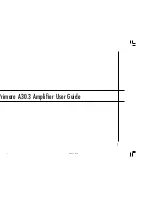
www.ti.com
Power Supply Decoupling, C
S
BSN and BSP Capacitors
VCLAMP Capacitor
V
BYP
Capacitor Selection
SHUTDOWN OPERATION
MUTE Operation
TPA3122D2
SLOS527A – DECEMBER 2007 – REVISED DECEMBER 2007
The TPA3122D2 is a high-performance CMOS audio amplifier that requires adequate power supply decoupling
to ensure that the output total harmonic distortion (THD) is as low as possible. Power supply decoupling also
prevents oscillations for long lead lengths between the amplifier and the speaker. The optimum decoupling is
achieved by using two capacitors of different types that target different types of noise on the power supply leads.
For higher frequency transients, spikes, or digital hash on the line, a good low equivalent-series-resistance (ESR)
ceramic capacitor, typically 0.1
µ
F to 1 µF placed as close as possible to the device V
CC
lead works best. For
filtering lower frequency noise signals, a larger aluminum electrolytic capacitor of 220
µ
F or greater placed near
the audio power amplifier is recommended. The 220-
µ
F capacitor also serves as local storage capacitor for
supplying current during large signal transients on the amplifier outputs. The PVCC terminals provide the power
to the output transistors, so a 220-µF or larger capacitor should be placed on each PVCC terminal. A 10-µF
capacitor on the AVCC terminal is adequate.
The half H-bridge output stages use only NMOS transistors. Therefore, they require bootstrap capacitors for the
high side of each output to turn on correctly. A 220-nF ceramic capacitor, rated for at least 25 V, must be
connected from each output to its corresponding bootstrap input. Specifically, one 220-nF capacitor must be
connected from LOUT to BSL, and one 220-nF capacitor must be connected from ROUT to BSR.
The bootstrap capacitors connected between the BSx pins and corresponding output function as a floating power
supply for the high-side N-channel power MOSFET gate drive circuitry. During each high-side switching cycle,
the bootstrap capacitors hold the gate-to-source voltage high enough to keep the high-side MOSFETs turned on.
To ensure that the maximum gate-to-source voltage for the NMOS output transistors is not exceeded, one
internal regulator clamps the gate voltage. One 1-
µ
F capacitor must be connected from VCLAMP (pin 11 for
PWP and pin 9 for DIP package) to ground and must be rated for at least 16 V. The voltages at the VCLAMP
terminal may vary with V
CC
and may not be used for powering any other circuitry.
The scaled supply reference (V
BYP
) nominally provides an AVcc/8 internal bias for the preamplifier stages. The
external capacitor for this reference C
BYP
) is a critical component and serves several important functions. During
start-up or recovery from shutdown mode, C
BSP
determines the rate at which the amplifier starts up. The second
function is to reduce noise produced by the power supply caused by coupling with the output drive signal. This
noise could result in degraded PSRR and THD + N.
The circuit is designed for a C
BSP
value of 1
µ
F for best pop performance. The inputs caps should be the same
value. A ceramic or tantalum low-ESR capacitor is recommended.
The TPA3122D2 employs a shutdown mode of operation designed to reduce supply current (I
CC
) to the absolute
minimum level during periods of non-use for power conservation. The SHUTDOWN input terminal should be held
high (see specification table for trip point) during normal operation when the amplifier is in use. Pulling
SHUTDOWN low causes the outputs to mute and the amplifier to enter a low-current state. Never leave
SHUTDOWN unconnected, because amplifier operation would be unpredictable.
For the best power-up pop performance, place the amplifier in the shutdown or mute mode prior to applying the
power supply voltage.
The MUTE pin is an input for controlling the output state of the TPA3122D2. A logic high on this terminal causes
the outputs to run at a constant 50% duty cycle. A logic low on this pin enables the outputs. This terminal may be
used as a quick disable/enable of outputs when changing channels on a television or switching between different
audio sources.
The MUTE terminal should never be left floating. For power conservation, the SHUTDOWN terminal should be
used to reduce the quiescent current to the absolute minimum level.
Copyright © 2007, Texas Instruments Incorporated
Submit Documentation Feedback
13
Product Folder Link(s) :
TPA3122D2
Summary of Contents for TPA3122D2
Page 20: ......







































